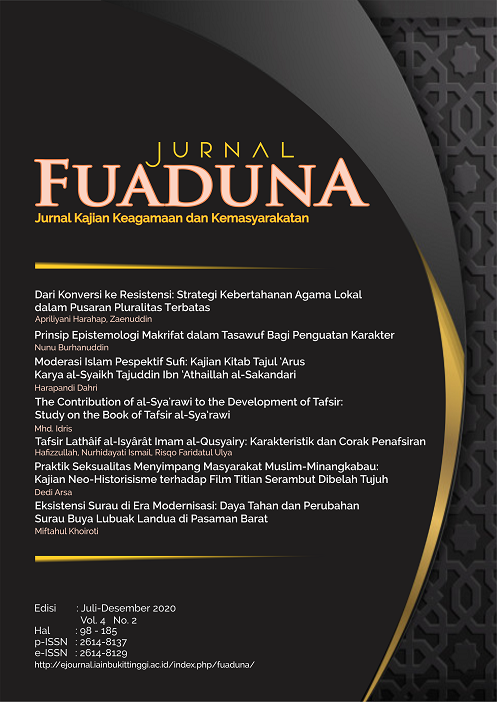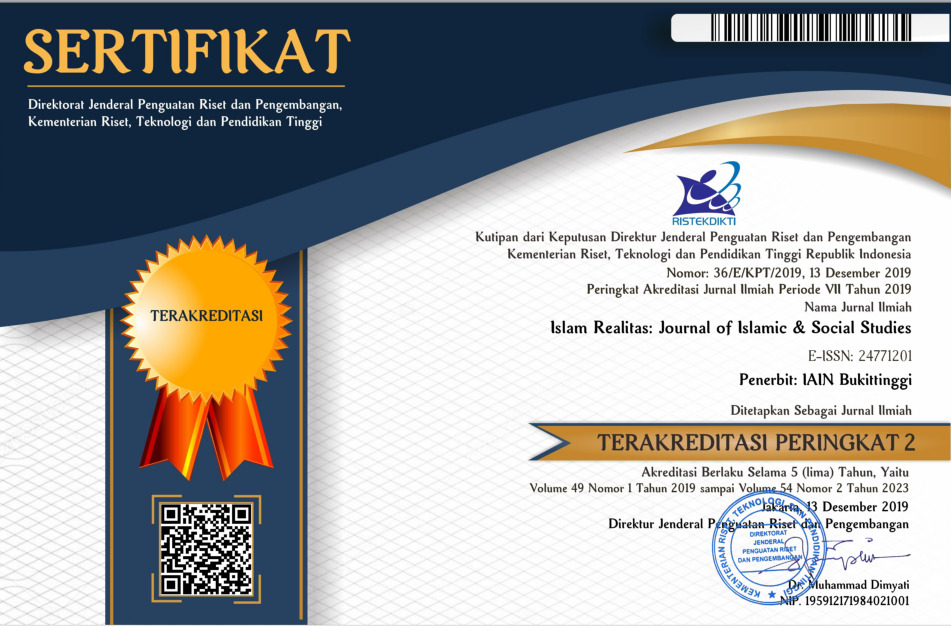Tafsir Lathâif al-Isyârât Imam al-Qusyairy: Karakteristik dan Corak Penafsiran
DOI:
https://doi.org/10.30983/fuaduna.v4i2.3594Keywords:
Al-Qusyairiy, Lathâif al-Isyârât, Sufism.Abstract
Imam al-Qusyairiy who is known as one of the leading figures of Sufi scholars, is also a Muhaddits and Mufassir. Among his monumental works in the field of interpretation is Lathâif al-Isyârât's interpretation book. In this study the author will illustrate how the book is, in terms of content, purpose of writing and the method used in its interpretation. This type of research is library research focusing on Lathâif al-Isyârât's interpretation of the book, using content analysis methods. The results showed that Tafsir al-Qusyairiy or Lathâif al-Isyârât was a classical interpretation which became a reference for enthusiasts of Isyariy-style interpretation written by a tsiqah hadith scholar. The Isyariy interpretation style referred to is the interpretation style based on the signs contained in the al-Qur'an verse which can only be obtained by Ma’rifah experts. In writing his commentary, Imam Al-Qusyairiy uses the ijmâli method, without being elaborate, so that it does not bore the reader, by interpreting one verse in its isyariy style then includes an analysis of the meaning contained by the verse, both zahir and spiritual meaning.
Imam al-Qusyairiy yang dikenal sebagai salah seorang sosok tokoh ulama sufi, ternyata juga seorang muhaddits dan mufassir. Di antara karya monumentalnya dalam bidang tafsir adalah kitab tafsir Lathâif al-Isyârât. Dalam penelitian ini penulis akan menggambarkan bagaimana kitab tersebut, baik dari segi gambaran isi, tujuan penulisan, dan metode yang dipakai dalam penafsirannya. Jenis penelitian ini merupakan penelitian kepustakaan (library research) dengan menfokuskan penelitian pada kitab tafsir Lathâif al-Isyârât, dengan menggunakan metode analisis isi. Hasil penelitian menunjukkan bahwa Tafsir al-Qusyairiy atau Lathâif al-Isyârât adalah tafsir klasik yang menjadi rujukan bagi peminat tafsir bercorak Isyariy yang ditulis oleh seorang ulama hadis yang tsiqah. Corak penafsiran Isyariy yang dimaksud yaitu yaitu corak penafsiran berdasarkan isyarat-isyarat yang terkandung dalam ayat al-Qur’an yang hanya dapat didapatkan oleh para Ahli Ma’rifah. Dalam penulisan tafsirnya Imam Al-Qusyairiy menggunakan metode ijmâli, tanpa berpanjang lebar, sehingga tidak membosankan pembacanya, dengan menafsirkan satu ayat dengan corak isyariy-nya kemudian menyantumkan analisis terhadap makna yang dikandung oleh ayat baik itu makna zhahir maupun makna bathin.
References
Al-Makatabah Al-Syamilah Versi 3.64
Al-Baghdâdiy, Abu Bakr Khatib. Târikh Baghdâd Wa Dzuyuluh. 1st ed. Beirut: Dar Al-Gharb Al-Islamiy, 2001.
Al-Dzahabiy, Syamsuddin Muhammad bin Ahmad bin Utsman. Siyaru A’lam Al-Nubala. Beirut: Muassasah Al-Risalah, 1985.
———. Tarikh Al-Islam Wa Wuffiyat Al-Masyâhir Wa Al-A’lâm. 1st ed. Beirut: Dâr al-Kutub Al-‘Arabiy, 1993.
Al-Qusyairy, Imam. Lathâif Al-Isyârât. 1st ed. Mesir: Al-Haiah Al-Mishriyyah Al-‘Ammah Lilkitab, 2000.
Al-Subkiy, Tajjuddin Abdul Wahab Bin Taqiyuddin. Thabaqât Al-Syâfi’iyah Al-Kubrâ. Juz 5. Beirut: Hijr li al-Thiba’ah wa al-Tauzi’, n.d.
Arrasyid. “Tasawuf Dan Problematika Modernitas: Menimbang Maqamat Dan Ahwal Abu Nashr as-Sarraj.†Fuaduna: Jurnal Kajian Keagamaan Dan Kemasyarakatan 02, no. 02 (2018): 43–54.
Basyuniy, Ibrahim. Madkhal Tafsir Lathâif Al-Isyârât. Mesir: Al-Haiah Al-Mishriyyah Al-‘Ammah Lilkitab, 2000.
Dapit Amril, Hafizzullah. “Konsep Makar Dan Cara Mengatasinya Dalam Perspektif Al Qur’an.†Al Fawatih: Jurnal Kajian Al Quran Dan Hadis 1, no. 1 (2020): 31–46.
Hafizzullah, Dapit Amril, Muhammad Habibi Ilyas. “Metode Muhammad Al Amin Al Haraari Dalam Tafsîr Hadâiq Ar-Rauhi Wa Ar-Raihân.†Al Fawatih: Jurnal Kajian Al Quran Dan Hadis 1, no. 1 (2020): 62–77.
Hashim, Mahyuddin. “Tafsir Sufi Ishari and Its Comparison with Tafsir Al-Batiniah, Tafsir Sufi of Philosophy and Tafsir Scientific Ishari.†’Ulum Islamiyah 27, no. March (2019): 53–66.
Madid, Izzul. “Tafsir Sufi: Kajian Atas Konsep Tafsir Dengan Pendekatan Sufi.†Jurnal Wasathiyah 2, no. 1 (2018): 143–54.
Mahmud, Mani’ Abdul Halim. Manâhij Al-Mufassirîn. Kairo: Dâr al-Kutub al-Mishriy, 2000.
Mani’ Abdul Halim Mahmud. Muqaddimah Al-Risâlah Al-Qusyairiyah. Kairo: Dar Al-Sya’bi, 1989.
Downloads
Published
How to Cite
Issue
Section
Citation Check
License
Authors who publish with this journal agree to the following terms:
- Authors retain copyright and grant the journal right of first publication with the work simultaneously licensed under a Creative Commons Attribution-ShareAlike 4.0. that allows others to share the work with an acknowledgment of the work's authorship and initial publication in this journal.
- Authors are able to enter into separate, additional contractual arrangements for the non-exclusive distribution of the journal's published version of the work (e.g., post it to an institutional repository or publish it in a book), with an acknowledgment of its initial publication in this journal.
- Authors are permitted and encouraged to post their work online (e.g., in institutional repositories or on their website) prior to and during the submission process, as it can lead to productive exchanges, as well as earlier and greater citation of published work (See The Effect of Open Access).





